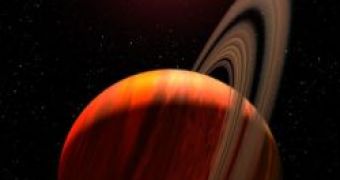During the span of the Royal Astronomical Society's National Astronomy Meeting that took place last week in Belfast, astronomers revealed the latest results of their studies. One of the scientists present there, Martin Dominik from the St Andrews University, pointed out that he and his team discovered a distant star system bearing two planets relatively similar to our two largest gas giants, Jupiter and Saturn, orbiting around the central star with a size roughly half of that of the Sun.
It has been quite clear for more than a decade that our solar system is in no matter unique in the universe and that there are possibly billions of other star systems bearing some resemblance to our own. Dominik suggested that this particular star system may even harbor a rocky planet such as Mars, Venus or Earth, however it will take some time before we will be able to accurately determine whether this is the case or not.
"We found a system with two planets that take the roles of Jupiter and Saturn in our solar system. These two planets have a similar mass ratio and similar orbital radius and a similar orbital period. It looks like this may have formed in a similar way to our solar system. And if this is the case, it looks like our solar system cannot be unique in the universe. There should be other similar systems out there which could host terrestrial planets," said Dominik.
Rocky planets
The star system Dr Dominik refers to is located about 5,000 light years away from Earth, around a star dubbed OGLE-2006-BLG-109L. Although more than 270 exo-planets have been discovered so far, only 10 percent of the star systems contain more than one planet, or at least only one was discovered so far.
Most of the detection techniques used today give a major advantage for the discovery of massive gas giants orbiting their stars from a short distance. The new planets, for example, have been found through a technique involving gravitational micro-lensing, in which light emitted by the parent star is being magnified by the powerful gravitational field of the planet.
"It's a kind of scaled-down version of our solar system. The star the planets are orbiting is half as massive as the Sun and they orbit half as distant to their host star as Jupiter and Saturn orbit around the Sun," said Dominik.
Nonetheless, the primary mission of exo-planet detection is not finding gas giants, but rocky planets similar to our own, preferably habitable. With the latest technological improvements, astronomers can now use the gravitational the micro-lensing technique to detect rocky planets well bellow the mass of our planet, and even to determine whether it has an atmosphere or it lies in the habitable orbital area of the star system. According to Dominik, most of the astronomer teams working in the exo-planetary detection field are split between favoring gravitational micro-lensing and the transit technique, both of them employed to detect small planets. However, he also reveals that neither of the two is currently capable of detecting a rocky planet in the OGLE-2006-BLG-109L star system.

 14 DAY TRIAL //
14 DAY TRIAL //